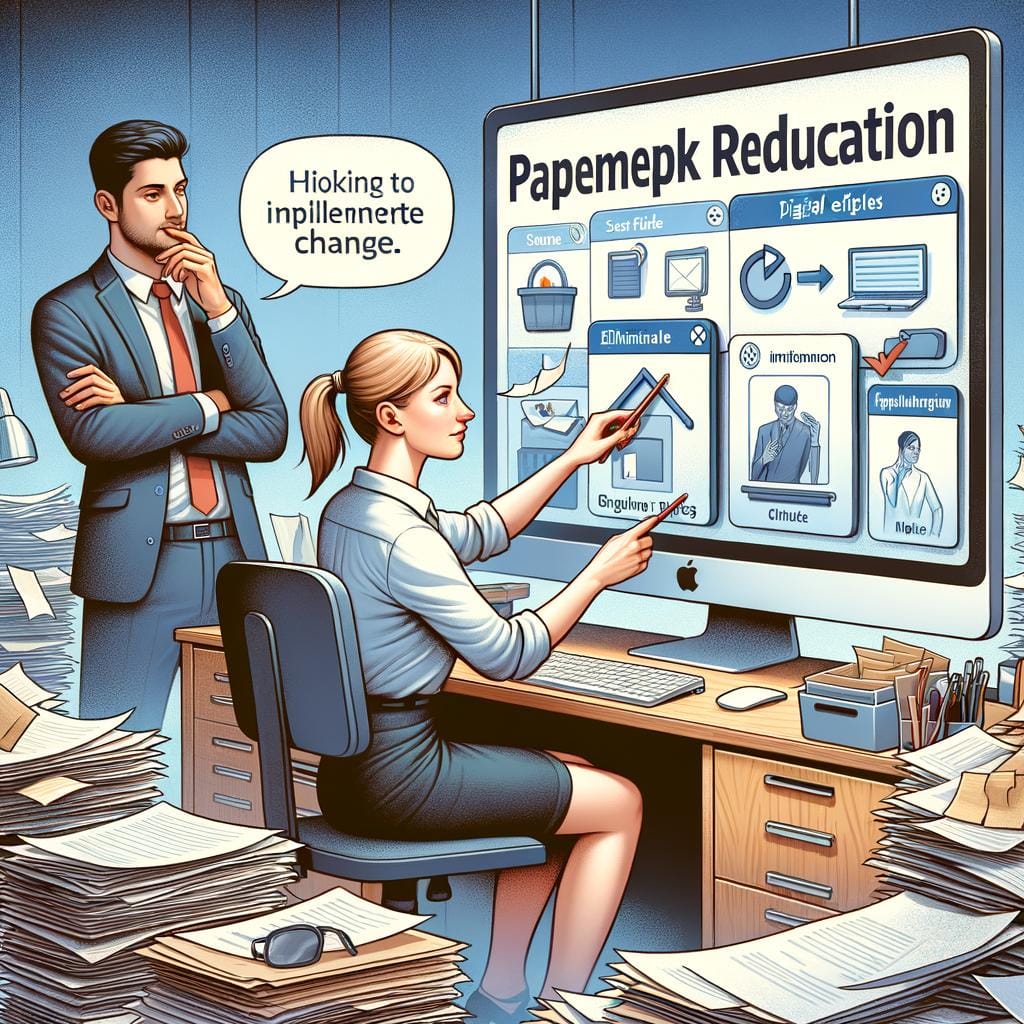In today’s fast-paced world, the constant flood of paperwork can easily overwhelm both individuals and businesses, leading to inefficiency, disorganization, and unnecessary stress. That’s why adopting paperwork reduction tips is essential for streamlining processes and improving productivity. Whether it’s clearing out the clutter on your desk at home or implementing a more efficient filing system in the office, taking steps to reduce paperwork can have a significant impact on your overall well-being.
By reducing paperwork, individuals can experience a myriad of benefits, including increased efficiency in completing tasks, enhanced organization in accessing essential documents, and a reduced sense of overwhelm from dealing with piles of paper. Digitalizing paperwork is one effective way to cut down on physical clutter while also making information readily accessible. Moreover, implementing strategic organization systems like color-coding or labeling can further simplify the process of managing paperwork effectively.
In this blog post, we will delve into practical tips for reducing paperwork both at home and in the workplace. From digitalizing physical documents to setting priorities for tackling paperwork tasks, readers will learn valuable strategies for decluttering their spaces and minds. By incorporating automation tools and maintaining regular maintenance habits for a streamlined workflow, individuals can enjoy a more productive and organized environment that promotes peace of mind.
Benefits of Reducing Paperwork
Reducing paperwork can have numerous benefits in both personal and professional settings. One of the key advantages of having less paperwork is increased efficiency. By reducing the amount of physical documents to sift through, individuals can save valuable time that would otherwise be spent searching for information. This increased efficiency can lead to higher productivity levels and a smoother workflow.
Another significant benefit of reducing paperwork is improved organization. When there are fewer papers cluttering desks or filing cabinets, it becomes easier to maintain an organized workspace. With proper systems in place, such as color-coding or using labels, individuals can quickly locate important documents when needed. This organizational structure not only enhances productivity but also reduces the likelihood of misplacing crucial information.
In addition to increased efficiency and organization, reducing paperwork can also contribute to reduced stress levels. The overwhelming presence of stacks of paper can create a sense of chaos and disarray in both personal and professional environments.
By decluttering and simplifying the amount of paperwork in one’s surroundings, individuals can experience a sense of calmness and focus. Implementing effective paperwork reduction tips not only leads to a more streamlined workflow but also helps in promoting overall well-being by minimizing stress-inducing factors.
Digitalize Paperwork
In today’s digital age, converting physical documents into a digital format can not only save space but also make information easily accessible. One of the most effective paperwork reduction tips is to scan important documents and store them on your computer or cloud storage.
This eliminates the need for bulky file cabinets and allows you to quickly search for specific documents with just a few clicks. By creating digital copies of your paperwork, you can streamline your workflow and increase efficiency in managing your personal or professional files.
Another useful strategy to digitalize paperwork is to use mobile scanning apps that allow you to capture documents directly from your smartphone. These apps often have features like optical character recognition (OCR) that can convert scanned images into editable text, making it easier to organize and search for specific information within your documents. Whether you’re on the go or in the office, having a mobile scanning app handy can significantly reduce the amount of physical paperwork you accumulate.
Additionally, investing in a document management system can help you categorize, tag, and retrieve digital documents with ease. These systems often include advanced search functionalities, version control options, and secure sharing capabilities that enhance collaboration among team members. With proper organization and digital tools in place, you can effectively minimize paper clutter while ensuring that important information is stored safely and conveniently.
| Advantages of Digitalizing Paperwork | Benefits |
|---|---|
| Saves physical space | Increased efficiency |
| Easily accessible information | Streamlined workflow |
| Enhanced organization | Improved productivity |
Implement Organization Systems
One of the most effective ways to reduce paperwork clutter and improve organization is by implementing efficient organization systems. By creating a filing system that is easy to maintain and navigate, individuals can save time, reduce stress, and increase productivity in both personal and professional settings. Color-coding and labeling are popular strategies that can be easily customized to suit individual preferences and needs.
Color-coding documents is a visually appealing method that helps distinguish different categories or types of paperwork at a glance. Assigning specific colors to various file categories, such as finances, medical records, or personal documents, can streamline the retrieval process and make it easier to locate important information quickly. Additionally, using color-coded labels on folders or tabs can further enhance the efficiency of the filing system.
In addition to color-coding, utilizing labels on folders, boxes, or drawers can significantly improve the organization of paperwork. Clearly labeled containers help indicate what contents are stored inside each one, making it simpler to identify where specific documents are located. Labels should be descriptive yet concise to ensure clarity and avoid confusion when searching for specific paperwork. Implementing these organization systems not only reduces clutter but also enhances accessibility and ease of use for individuals seeking particular information.
| Benefits of Organization Systems | Examples |
|---|---|
| Enhanced efficiency | Color-coding different document categories |
| Improved accessibility | Using clear labels on folders |
| Reduced stress | Easy navigation through organized files |
Set Priorities
Prioritizing paperwork tasks is crucial in both personal and professional settings to ensure that important matters are addressed promptly and efficiently. By setting priorities, individuals can focus their time and energy on essential documents while delegating or eliminating non-essential paperwork altogether. Here are some tips on how to effectively prioritize paperwork tasks:
- Identify Urgent Matters: Start by identifying which documents or tasks require immediate attention. This could include deadlines, legal documents, or critical information that needs to be addressed promptly.
- Delegate Non-Essential Tasks: For paperwork that is not urgent but still requires attention, consider delegating these tasks to others if possible. By entrusting certain responsibilities to colleagues or family members, you can free up your time for more critical matters.
- Eliminate Unnecessary Documents: Take the time to review your paperwork regularly and eliminate any unnecessary documents. This could include old receipts, duplicate files, or outdated information that no longer serves a purpose.
By following these tips for prioritizing paperwork tasks, individuals can streamline their workflow, reduce stress levels, and ensure that they are focusing on what truly matters. Remember that effective prioritization is key to maintaining a clutter-free workspace and staying organized amidst the influx of documents in our daily lives. Utilize these strategies to stay on top of your paperwork and improve productivity in all aspects of your life.
Lastly, always remember that utilizing automation tools like electronic signatures, document management systems, and online cloud storage can further aid in streamlining your paperwork processes effectively. By combining prioritization strategies with automation tools, individuals can significantly reduce manual workloads and achieve a more efficient workflow overall. By implementing these techniques consistently and regularly reviewing your priorities, you can maintain a decluttered workspace while managing your paperwork effectively over time.
Decluttering Tips
Dealing with endless piles of paperwork can be overwhelming and stressful, but with the right decluttering tips, you can regain control of your space and improve your productivity. Here are some practical suggestions to help you declutter your paperwork efficiently:
- Start by sorting through your documents and separating them into categories such as important, temporary, or unnecessary.
- Shred any sensitive information that is no longer needed to protect your privacy and prevent identity theft.
- Recycle old papers that have served their purpose, such as outdated manuals, expired contracts, or irrelevant receipts.
- Keep only essential documents that are current, relevant, and regularly used to minimize clutter and confusion.
By following these decluttering tips, you can reduce the amount of paperwork in your office or home while creating a more organized and streamlined environment. Remember to regularly review and purge your documents to prevent future accumulation of unnecessary paperwork.
In addition to physical decluttering, consider implementing digital organization systems to store important files electronically. By converting paper documents into digital format and utilizing cloud storage solutions, you can save space, access information quickly, and easily backup important files for added security. Embracing a combination of physical decluttering practices and digital organization tools will help you maintain a clutter-free workspace while improving overall efficiency in managing paperwork.
Automation Tools
Electronic Signatures
One of the most efficient ways to reduce paperwork is by incorporating electronic signatures into your workflow. Electronic signatures not only save time and resources but also eliminate the need for printing, signing, and scanning documents. There are various platforms available that offer secure and legally binding electronic signature solutions, making it a convenient option for both personal and professional paperwork.
Document Management Systems
Implementing a document management system can significantly streamline your paperwork processes by organizing and storing documents in a centralized digital location. These systems allow users to easily retrieve, edit, and share files with colleagues or clients, reducing the reliance on physical paper copies. By digitizing your documents through a document management system, you can improve collaboration, version control, and overall efficiency in managing paperwork.
Online Cloud Storage
Moving your documents to online cloud storage services like Google Drive, Dropbox, or Microsoft OneDrive can simplify paperwork management while ensuring accessibility from anywhere with an internet connection. Cloud storage not only reduces the clutter of physical papers but also provides backup security measures to protect your files from loss or damage.
With the ability to sync files across multiple devices and share them effortlessly with others, online cloud storage is a valuable tool for modernizing your paperwork processes. By utilizing these automation tools, individuals and organizations can transform their paper-heavy tasks into efficient digital workflows that save time, resources, and ultimately contribute to a more organized workspace.
Regular Maintenance
In conclusion, the implementation of paperwork reduction tips is crucial for individuals seeking to streamline their personal and professional lives. By reducing the amount of physical documents and adopting digital alternatives, individuals can experience numerous benefits such as increased efficiency, organization, and reduced stress levels. Digitalizing paperwork allows for easy access to information, saving space and promoting a more eco-friendly approach.
Moreover, setting up effective organization systems, such as color-coding or utilizing labels, can significantly enhance the ease of maintaining and navigating through important documents. Prioritizing paperwork tasks based on urgency and relevance can help individuals stay focused on what truly matters and prevent feeling overwhelmed by unnecessary clutter. Decluttering tips like shredding unnecessary papers, recycling old documents, and keeping only essential files are essential in creating a clean workspace that fosters productivity.
Lastly, the recommendation of automation tools like electronic signatures and document management systems can further streamline paperwork processes. Encouraging regular maintenance by consistently reviewing and purging unnecessary paperwork ensures that individuals maintain a decluttered workspace in the long run. Ultimately, by following these practical tips and strategies for reducing paperwork, individuals can achieve a more organized, efficient, and stress-free environment both at home and in the workplace.
Frequently Asked Questions
What Are the Requirements for the Paperwork Reduction Act?
The Paperwork Reduction Act (PRA) requires federal agencies to seek approval from the Office of Management and Budget (OMB) before collecting certain types of information from the public. This includes forms, surveys, and other information collection activities.
What Are the Exemptions for the Paperwork Reduction Act?
There are exemptions to the Paperwork Reduction Act that apply when collecting information is required for law enforcement purposes, national security issues, or to carry out essential agency functions. Additionally, voluntary collections of information or those used for agency communications may be exempted from the PRA’s requirements.
What Is Paperwork Reduction?
Paperwork reduction refers to efforts aimed at reducing the burden of paperwork on individuals and businesses by streamlining processes and minimizing unnecessary paperwork requirements. By cutting down on redundant forms and reports, organizations can improve efficiency and save time and resources for all parties involved.

Hello, I’m April Denton, your go-to expert for all things home decluttering and organization. With over a decade of experience helping individuals transform their living spaces into serene, clutter-free sanctuaries, I am passionate about the life-changing benefits of decluttering. My journey into the world of organization began out of necessity, juggling a busy career and a bustling household. I quickly realized that a well-organized home was the key to a more balanced, stress-free life.





